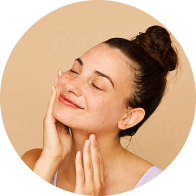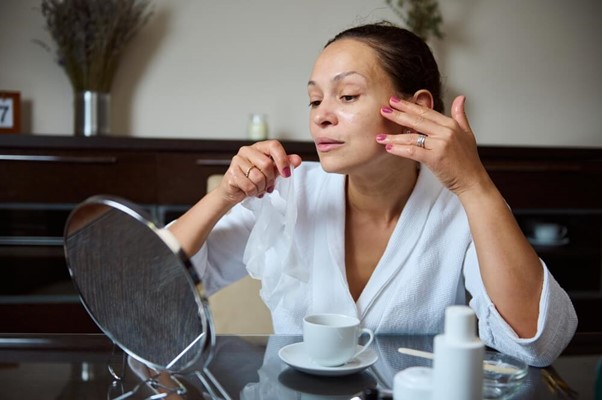.jpg)
If you’re suffering from problem skin, there’s no doubt you’ve heard about azelaic acid for acne. That’s because this dazzling little skincare ingredient is a serious weapon in the war against skin imperfections. And the good news is – it's not just acne that it gets to work on. Acelaic acid is a pigmentation powerhouse too – and can even help tackle tricky rosacea.
At MiQuest, our pharmaceutical formulation scientists combine AI technology to deliver the right prescription-grade skincare formulation for you. We use azelaic acid to combat a variety of skin concerns. And what’s great is that when you sign up for a skincare subscription with us, you’ll receive a personalised formulation that changes as your skin’s needs change.
What is Azelaic Acid?
Before we dive straight in with why azelaic acid works wonders on acne and pigmentation, you’re probably wondering where this mighty ingredient comes from. We’ll tell you -
Azelaic acid is a natural organic compound that exists in rye, wheat, and barley. It boasts properties that are antimicrobial and anti-inflammatory meaning it’s great at getting to work on skin imperfections.
Is Azelaic Acid Good for Acne?
The one-word answer is ‘yes’. But to delve more deeply into just why azelaic acid is an acne nemesis, we’ll explain. Azelaic acid isn’t just great for tackling skin concerns that already exist, it’s great for helping to prevent problems before they’ve even kicked off.
That’s because this awesome skincare ingredient is stacked full of powerful antimicrobial and anti-inflammatory properties meaning it can soothe and calm skin, and swipe away spot-causing bacteria from pores before it can do its worst.
Azelaic Acid for Hyperpigmentation
So, now you know the answer to, ‘is azelaic acid good for acne’, we’re sure you want to get to grips with azelaic acid for hyperpigmentation.
Hyperpigmentation is when areas of your skin become darker in appearance. This can happen due to:
- The natural ageing process
- Too much exposure to sun
- Inflammation
- A condition called rosacea
Hyperpigmentation is a common concern, but one that many people dislike – as a naturally even skin tone is the look that’s most sought after. Fortunately, azelaic acid calms pigmentation problems and is able to help you achieve a skin tone that’s more even in appearance.
t does this by getting to work on an enzyme named tyrosinase. And it’s this enzyme that’s responsible for producing dark patches – or hyperpigmentation marks – on your skin.
So, whether your pigmentation problems are caused by overexposure to the sun, post-acne scarring, melasma, or rosacea, azelaic acid for pigmentation is a must.
Azelaic Acid for Exfoliating and Brightening
Whilst azelaic acid doesn’t work primarily as an exfoliator, it does boast mild exfoliation properties that help to shift dead skin cells and boost skin cell turnover. So, whilst azelaic acid is pigmentation busting, it’s also helping to exfoliate and brighten your skin too. Which is great news for you as it all helps to give you a fresh, youthful, blemish-free glow.
What are the Benefits of Azelaic Acid?
So, what are the benefits of azelaic acid – or perhaps more appropriately - what aren’t the benefits? This must-try skincare ingredient is exceptional when it comes to tackling acne and hyperpigmentation and boasts multiple benefits.
- It’s gentle on your skin – you can use it once or twice a day
- Can reduce skin sensitivity
- Lightens pigmentation patches
- Removes, decreases, and limits bacteria on the skin
- Inhibits tyrosinase so over-production of melanin is diminished
- Available in gel, cream, and foam form
- You can wear it under makeup
- Is well tolerated
Azelaic acid on Prescription?
The great news is that if you’re keen to try azelaic acid you don’t need a prescription to do so. The highest strength of azelaic acid is prescription-grade and is 20%. You can also get lower concentrations, but when used to target skincare concerns anything from 10% azelaic acid and upwards is most common.
Side Effects of Azelaic Acid
As you might expect from its name, it’s possible that you could experience a few minor side effects when using azelaic acid. These include -
- Skin peeling
- Dryness of the skin
- Burning skin
While the above side effects are the most common, it’s also possible (but rare) to experience blistering, swelling, flaking, joint pain, difficulty breathing, a skin rash, or fever. Of course, if you notice any of these symptoms while using azelaic acid, speak to your GP as soon as possible.
Despite these possible side effects, azelaic acid is actually milder than other popular skincare ingredients which you’re probably familiar with – salicylic acid, glycolic acid, and alpha hydroxy acid.
In order to keep potential side effects to a minimal when using azelaic acid, you should avoid using alcoholic cleanser, astringents, or any harsh abrasive skincare products. And always use a broad-spectrum suncream of SPF30+ to keep your skin protected from the sun’s damaging rays.
At MiQuest, we regularly check in with our subscribers to see how their skin is progressing. So, if we see a change in your skin that doesn’t look right, we can switch up the formulation to ensure it’s delivering just what your skin needs.
What about Results?
When it comes to using azelaic acid you’ll need to be a little patient on the waiting front. Wonders don’t happen overnight. Depending on what skin concern you’re treating, you could be looking at seeing best results in -
- Approximately 6 weeks for acne
- 6+ months for pigmentation
- Around 2 weeks with improvements continuing for 3-6 months for rosacea
Decision Time
Think azelaic acid is right for you? It could well be! If you have either acne, hyperpigmentation, or rosacea and want to treat your condition gently with a proven skincare ingredient that’s generally well tolerated, an azelaic product – or facial treatment – could set you on the path to skin you feel happy in.
Be patient, let it get to work properly, and if you stick with it, you should notice a difference to your skin a few weeks, or months further down the line. Let the team at MiQuest put together the ideal formulation for your skin, and you’ll soon start seeing results.






AI-Empowered Dermatology, Personalised For You.






